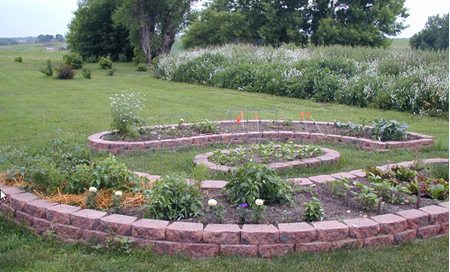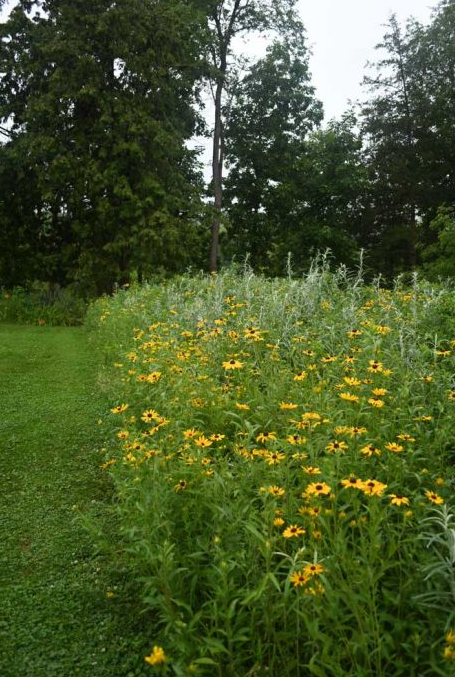Click below to listen to my 2 min. Garden Bite radio show/podcast: Planting on a septic system
Audio PlayerMany years ago I lived on 5 acres that had a septic mound. It was hard to mow and the rider was not to be used on top. My clever idea was to plant native seed. Well, this way a LONG time ago when I was very new at the gardening game and I didn’t research it the way I should have.

There are rules to planting on septic systems and Prairie Moon Nursery has come up with a Septic Safe Seed Mix.
In their words, “This SepticSafe seed mix has all the qualities to make that crappy site into something beautiful and beneficial. These species are rugged; they will thrive in the moisture-sucking gravel above tanks and leach fields, as well as withstand the additional heat emitted from below. Once established, this combination of plants averages 2 to 3 feet in height. The colorful flowers throughout the growing season will provide year-long interest and support local pollinators like butterflies, bees, and birds”.

Depending on what part of the country you live in, the seed mix could be different. Check with your areas native seed companies. Prairie Moon has a tongue in cheek method of sharing the DO’s and Don’ts. Check the link above!

There are things we would normally do when planting that we DON’T do on septic sites.
For instance:
- Don’t add additional soil
- Don’t mulch heavily
- Don’t irrigate or water excessively
- Don’t till
- Don’t dig deeply and a few more don’ts.
- DO plant perennials, drought tolerant and non-wood plants.
The mix is basically half grasses and half wildflowers. Most of these plants would thrive in our colder climates.
What’s in this particular mix:
|
Artemisia ludoviciana (Prairie Sage) |
0.12 |
|
Asclepias tuberosa (Butterfly Weed) |
1.93 |
|
Callirhoe triangulata (Clustered Poppy Mallow) |
0.96 |
|
Chamaecrista fasciculata (Partridge Pea) |
15.44 |
|
Coreopsis lanceolata (Lance-leaf Coreopsis) |
1.93 |
|
Crotalaria sagittalis (Rattlebox) |
0.96 |
|
Dalea purpurea (Purple Prairie Clover) |
2.41 |
|
Echinacea pallida (Pale Purple Coneflower) |
1.93 |
|
Euphorbia corollata (Flowering Spurge) |
0.48 |
|
Helianthus occidentalis (Western Sunflower) |
0.96 |
|
Lupinus perennis (Wild Lupine) |
2.41 |
|
Monarda punctata (Spotted Bee Balm) |
0.96 |
|
Oenothera rhombipetala (Sand Evening Primrose) |
0.48 |
|
Penstemon grandiflorus (Large-flowered Beardtongue) |
3.86 |
|
Rudbeckia hirta (Black-eyed Susan) |
3.38 |
|
Solidago nemoralis (Old Field Goldenrod) |
0.12 |
|
Symphyotrichum oolentangiense (Sky Blue Aster) |
1.06 |
|
Symphyotrichum sericeum (Silky Aster) |
1.69 |
|
Tephrosia virginiana (Goat’s Rue) |
2.17 |
|
Tradescantia ohiensis (Ohio Spiderwort) |
2.89 |
|
Verbena stricta (Hoary Vervain) |
1.93 |
|
Zizia aptera (Heart-leaf Golden Alexanders) |
0.96 |
|
Total of WILDFLOWERS: |
49.06 % |
|
GRASSES, SEDGES & RUSHES |
|
|
Botanical Name (Common Name) |
% by wt. |
|
Bouteloua curtipendula (Side-oats Grama) |
21.61 |
|
Carex brevior (Plains Oval Sedge) |
3.86 |
|
Carex muehlenbergii (Sand Bracted Sedge) |
0.96 |
|
Eragrostis spectabilis (Purple Love Grass) |
0.24 |
|
Juncus tenuis (Path Rush) |
0.72 |
|
Koeleria macrantha (June Grass) |
1.93 |
|
Schizachyrium scoparium (Little Bluestem) |
21.61 |
|
Totals of GRASSES, SEDGES & RUSHES: |
50.94 % |
Once a native area is established, which takes 3 or more years, it’s amazing!
